Why I regret my years as a tanning addict
- Published
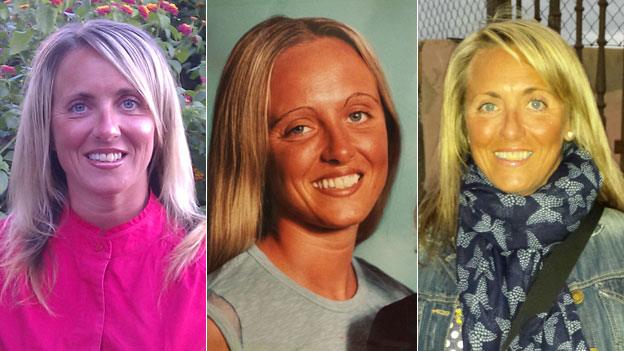
Laura May McMullan spent years under sunbeds and sunbathing on holiday. Then she developed skin cancer and realised her desire to be brown had put her life in danger.
I was a tanning addict.
Being brown was being me. If I wasn't tanned, then I didn't look like "me". Silly I know, but that's just the way I felt.
Having a tan made me feel better about myself. I used to say it was like a "tonic" - it made me feel more confident and more healthy.
In reality, my overwhelming desire to be tanned couldn't have been more unhealthy.
I don't know where that desire came from - I was always pale throughout my school years. I don't have an addictive personality. I just think sunbeds have the "power" to make you feel good. And I know serotonin - the "happy hormone" - can be released when your body is exposed to sunlight.
From about the age of about 16 I started using sunbeds. First it was once a week, then twice, then I got to a point of using them every day. I admit I became addicted.
BBC Inside Out meets tanning addicts
My parents tried to tell me that I was damaging my skin, but I never thought about the consequences. I used them for about 10 years, going to a variety of salons and also hiring them at home.
It was my choice and I'm not blaming anyone for what happened to me. But I was never given an "informed" choice. Not once in all the 10 years did any salon staff give me any advice about my skin, or about the safe level of UV exposure, and there were no information signs.
But most of my friends could see the dangers of what I was doing and many of them tried to warn me. In fact, it was a standing joke with all my friends in the office every time I went on holiday.
"What colour are you aiming for this time?" My reply was always "mahogany".
It felt like a cloud evaporating - I could face whatever was thrown at me, it lifted my spirits and it made me feel good about myself. Along the way, I obviously developed a deeper and deeper tan - so I became used to seeing myself brown, and I didn't like looking pale anymore.
Between using sunbeds and also going abroad six weeks a year, I was putting myself in danger.
I actually stopped using sunbeds about 12 years ago. I could see the wrinkles increasing. Not once though did it ever enter my head that I could be affected by skin cancer, let alone the deadliest type, malignant melanoma.
It's been the toughest time of my life, but I'm so thankful I survived it and am still here to try to warn others.
My life changed forever when, on 5 Feb 2014, I got the news of my cancer. My fiance and I were five days into our two-week holiday in Fuerteventura and were just about to settle on the balcony with a refreshing cold drink after a lovely hot day in the sun.
I received a text message asking me to call the dermatologist who'd done a biopsy a month earlier on a little red spot on the back of my leg.
More than six months before, in June 2013, I had found the little red raised spot and thought it was an insect bite. It didn't hurt or bleed, it was just something new that popped up. My doctor and the dermatologist both thought it was an insect bite that had got infected. I wasn't worried in the slightest.
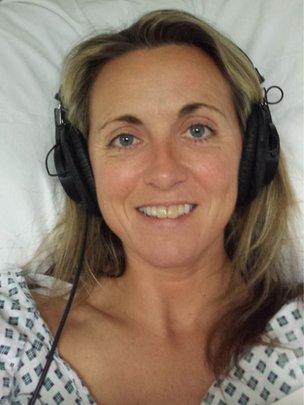
After her surgery and without a tan
But I remember standing in the holiday apartment and hearing the dermatologist's words: "I'm so sorry to tell you it's melanoma." I didn't really know what that meant, but I felt sick to the pit of my stomach.
I was shaken, but I'm an extremely positive person and I had to believe I was going to be OK. I was in the hands of some of the world's leading melanoma consultants - and I knew I was getting the best care possible from my consultant, Mr Oudit and his team at The Christie hospital in Manchester.
At the end of February last year I had a wider excision in the back of my leg and I chose to have a "sentinel lymph node biopsy". The melanoma had spread. I had to have all the lymph nodes cut out of my right groin and I also opted to have some removed from my pelvis laparoscopically.
On 4 June, a week after major surgery, I was told that no more melanoma was found. I hugged the consultant and thought that's it - I can get on with my life. I should have been jumping for joy but this is when I came crashing down and started to worry about what else was going on inside me.
Anyone who's had a cancer diagnosis will know that it doesn't just attack a certain part of your body, it affects every part of your life and your loved ones. I lost all my confidence. I didn't want to spend a minute on my own. At times I couldn't walk properly, I couldn't get in the bath, I couldn't drive and for weeks I had a drain attached to my leg and I had to inject myself every day to prevent any blood clots.

A short history of tanning
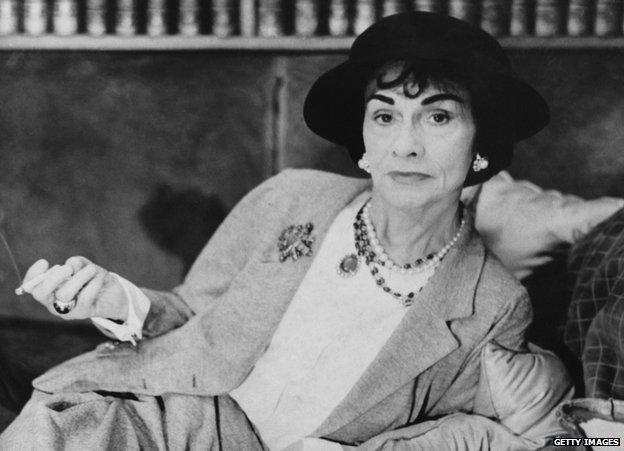
For centuries white skin was fashionable as it meant people were rich enough not to have worked outside
A pale complexion was achieved in the 17th Century by making a cream from powdered white chalk or white lead, mixed with egg white and vinegar
Fashion designer Coco Chanel is believed to have started the trend for tanned skin after she was accidentally sunburned on a cruise to Cannes in 1923
Perfumer Jean Patou is credited with creating the first tanning oil, Huile de Chaldee, in 1927

Worse still were thoughts about the future - how would my fiance and my mum cope without me? Would I be here in six months to see my birthday? Would I see Christmas? All these terrible thoughts were dragging me down. I didn't buy any new clothes for months.
On top of the emotional effects, I've been left with lymphedema in my leg. It's a build-up of fluid because of the removal of lymph nodes from my groin. I can live with a big leg though! I have to massage my leg twice a day, wear compression garments and avoid getting any insect bites and scratches from animals. I can't shave my leg.
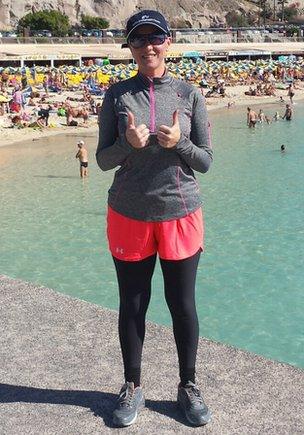
Now Laura wears factor 50 sun cream beneath her clothes
I would never want anyone to go through all the pain, worry and trauma that my family and I have endured - just because of trying to get a tan.
I definitely think people today are more aware about the dangers of tanning, but I think the majority still think "it won't happen to me." There are still around 3,000 tanning salons across the UK, and only 20% of them are regulated by the Sunbed Association (TSA) who do suggest limits on exposure. But who regulates the remaining 80%?
The tan's not worth it, especially if like me, you have fair skin, and you're prone to burning. While making the documentary for the BBC about my experiences, I was able to convince a young woman called Jess to give up using sunbeds.
Jess was much like me, being brown made her feel better about herself and she never thought about the consequences. At just 19, Jess had already been using sunbeds for four years, up to three times a week, and she used them free because she worked in a sunbed shop.
After finding the little red spot on the back of my leg, it was three months before I went to see my GP. I dread to think what might have happened if I'd left it any longer. I would urge people that if a mole changes in shape or colour, gets bigger or like mine, something new pops up, then please go to the doctors. Please don't bury your head in the sand. The sooner you catch it the better chance there is of a successful outcome.
Thoughts of having melanoma are with me every day - but I'm determined not to let them hold me back.

Embracing being pale
I've also had the confidence to go abroad again. It was a big test for me but after overcoming my initial fear, I was able to relax. I now put on factor 50 sun cream half an hour before I go out, and I cover up from head to toe. Frankly, who cares what I look like.
I totally avoid the midday sun and I now sit in the shade. I even take my own spray tan on holiday with me. I can still be "mahogany", but now I fake it.
It used to be that I couldn't "feel like me" without a tan.
I still feel a bit like that today. I sometimes struggle in accepting the way I look. I'm completely pale. But I use a spray tan on my face to give me that "healthy glow".
There is no way I will ever sit out in the sun again. I just have to accept who I am and how I look.

Tanning advice
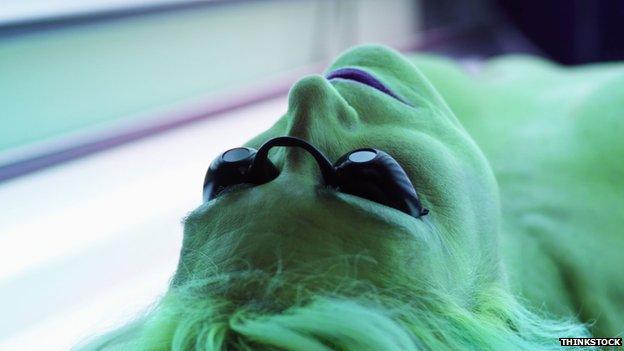
The Health and Safety Executive advises that any exposure to UV radiation from tanning equipment is potentially harmful, particularly for people who have...
fair, sensitive skin that burns easily or tans slowly or poorly
a history of sunburn, particularly in childhood
a large number of freckles and/or red hair
a large number of moles
are taking medicines or using creams that sensitise the skin to sunlight
a medical condition that is worsened by sunlight
anyone in your family has had skin cancer in the past
already have extensive skin damage due to sunlight

Inside Out, featuring Laura's story, is available to watch in the West Midlands on Monday February 23 at 19:30 GMT, or on BBC iPlayer.
Subscribe to the BBC News Magazine's email newsletter to get articles sent to your inbox.